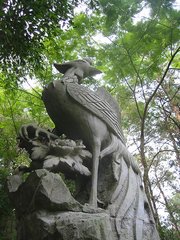Fenghuang
|
|
Fenghuang (Chinese: 鳳凰; pinyin: fènghuáng; Japanese: Hoo-Oo) are mythological Chinese birds that reign over all other birds. The males are called feng and the females huang. In modern times, however, such a distinction of gender is often no longer made and the feng and huang are blurred into a single female entity so that the bird can be paired with the Chinese dragon, which has male connotations. The fenghuang is also called the August Rooster (鶤雞 hùnjī). In the West, it is commonly referred to as the Chinese phoenix.
The fenghuang is said to be made up of the beak of a cock, the face of a swallow, the forehead of a fowl, the neck of a snake, the breast of a goose, the back of a tortoise, the hindquarters of a stag and the tail of a fish. Its body symbolizes the six celestial bodies. The head is the sky, the eyes are the sun, the back is the moon, the wings are the wind, the feet are the earth, and the tail is the planets. Its feathers contain the five fundamental colors.
The fenghuang has very positive connotations. It is a symbol of high virtue and grace. The fenghuang also symbolizes the union of yin and yang. It appears in peaceful and prosperous times but hides when trouble is near.
In ancient China, they can often be found in the decorations for weddings or royalty, along with dragons. This is because the Chinese considered the dragon and phoenix symbolic of blissful relations between husband and wife.
See also
Fenghuang is also a county in western Hunan province of China, formerly a subprefecture. Its name is written with the same Chinese characters as the mythological bird.fr:Fenghuang nl:Feng Huang ja:鳳凰 zh:凤凰

